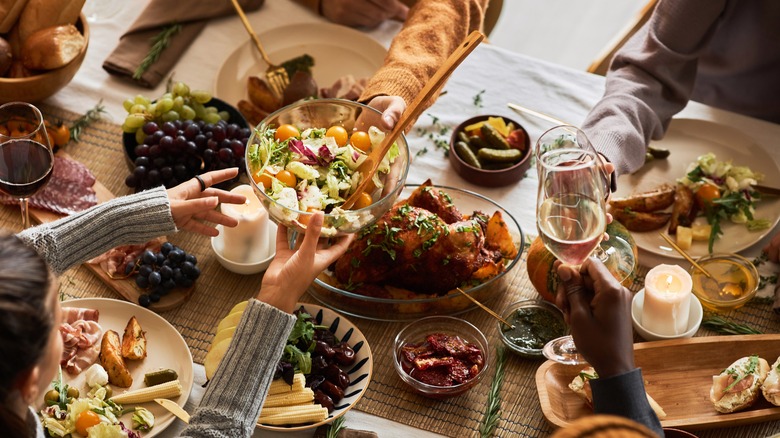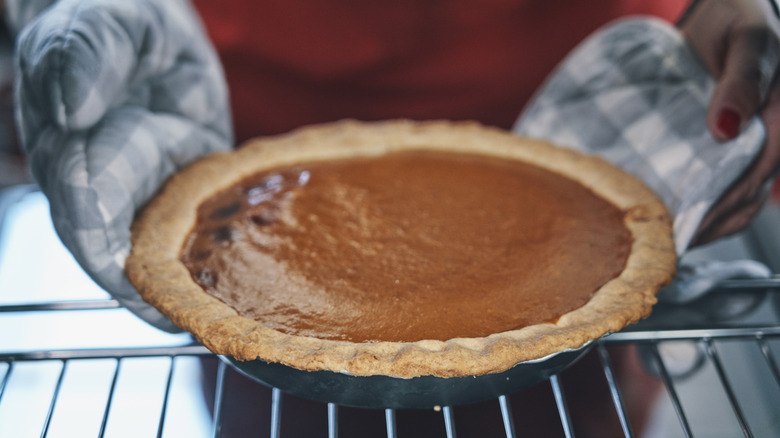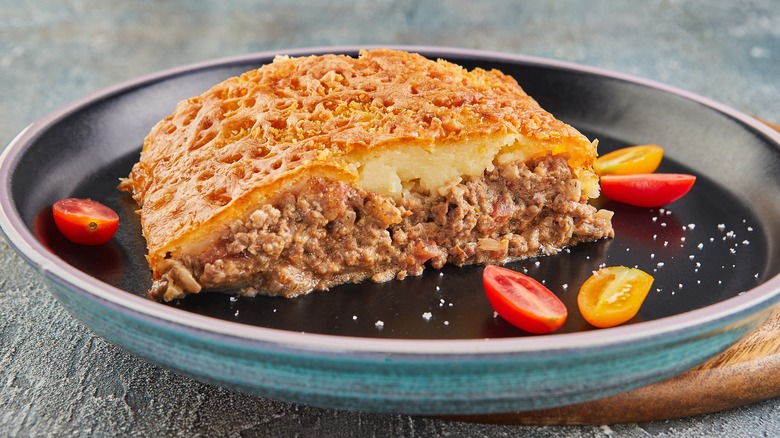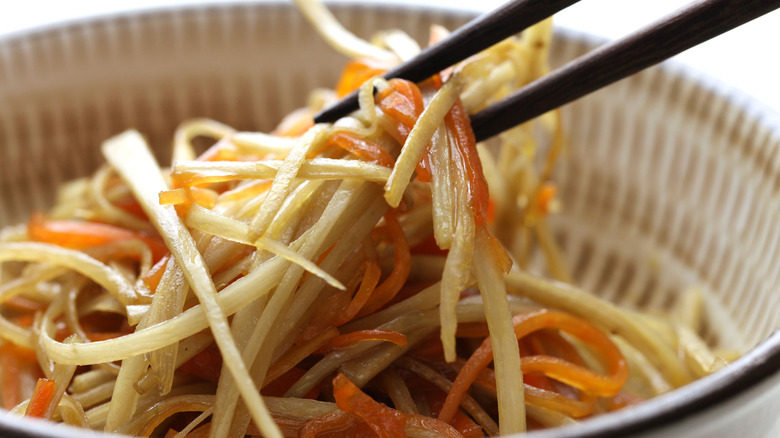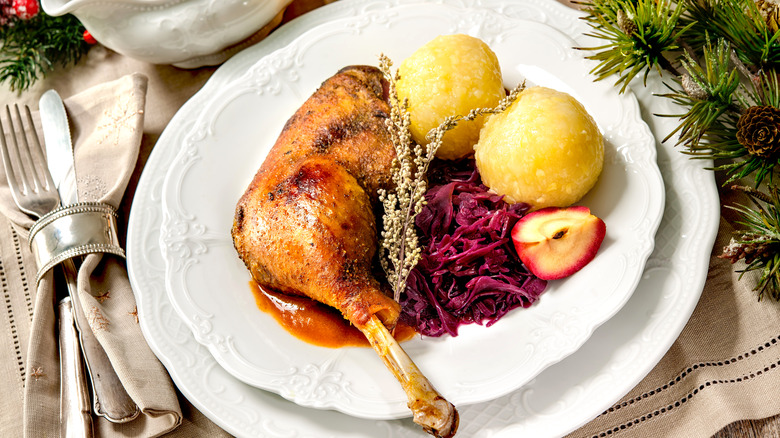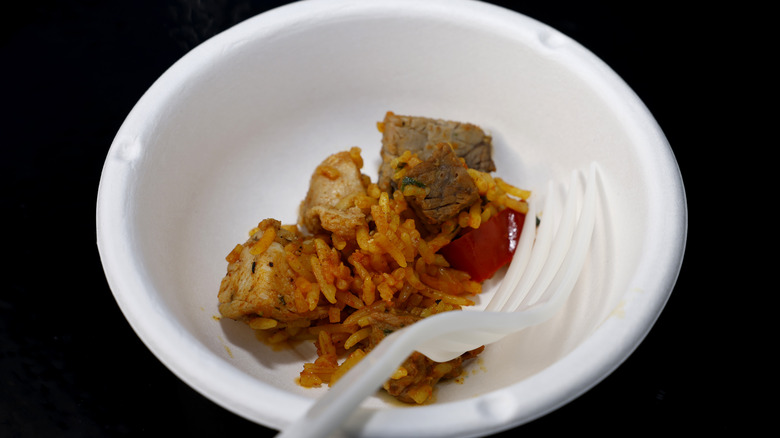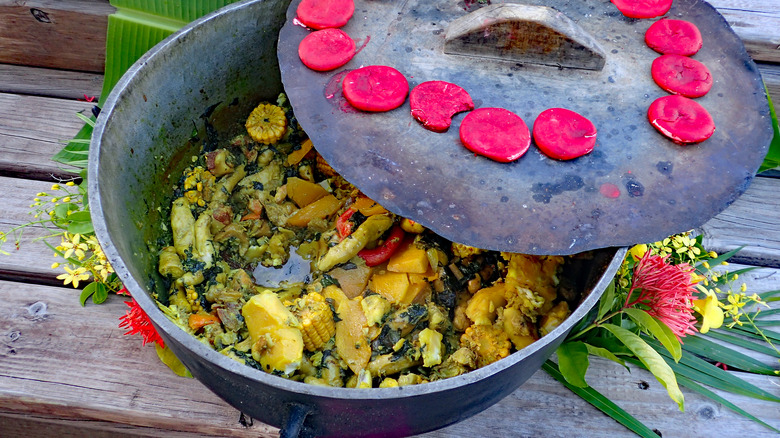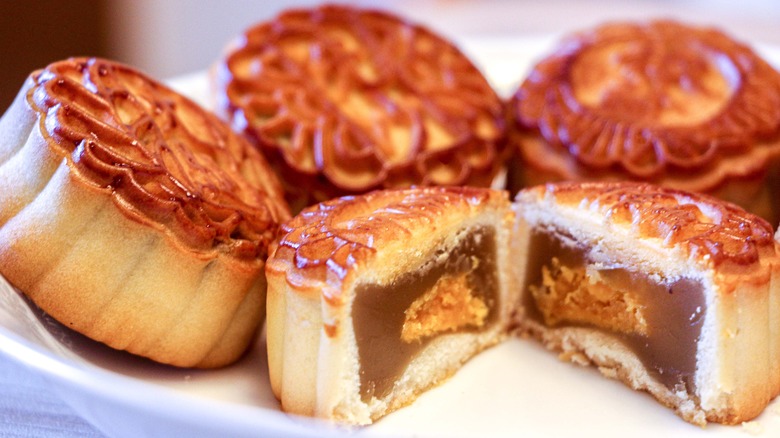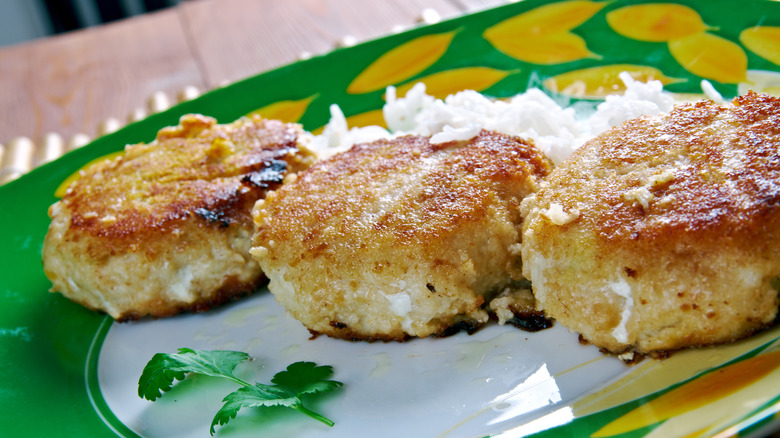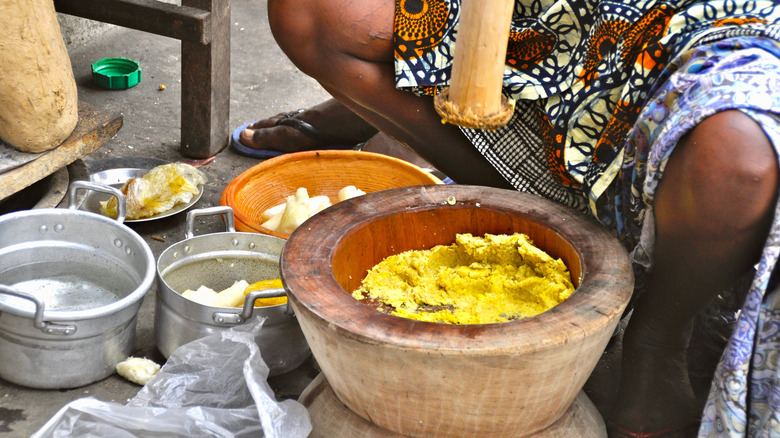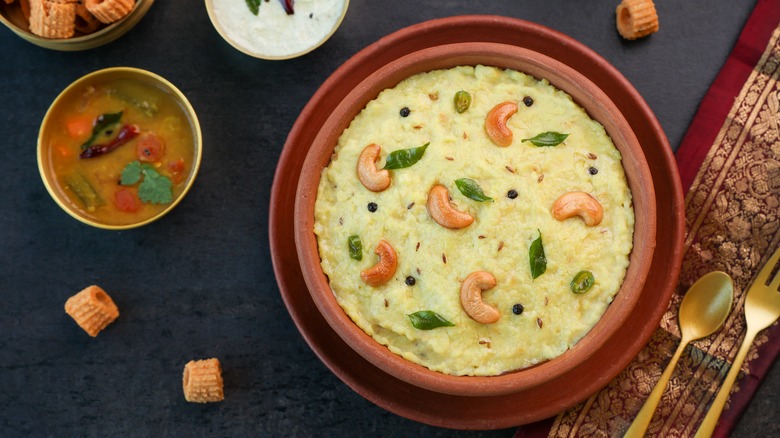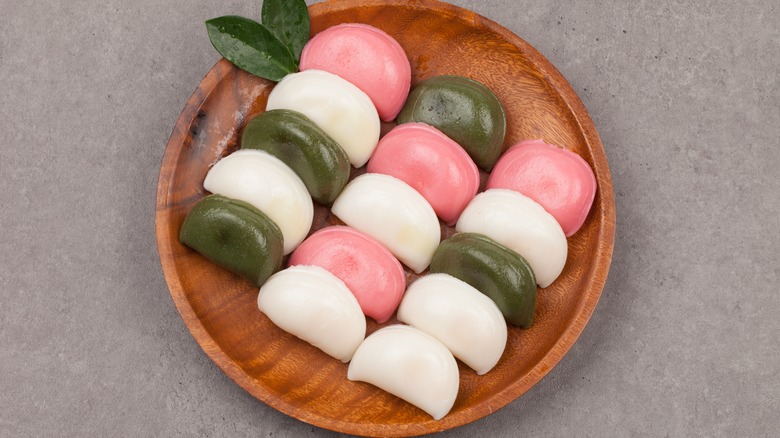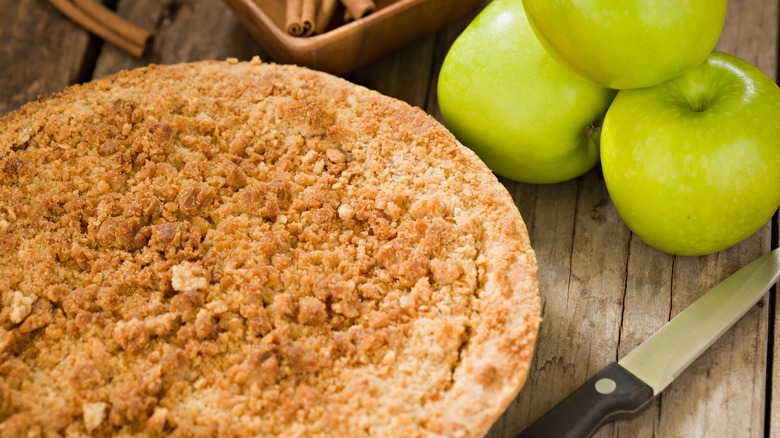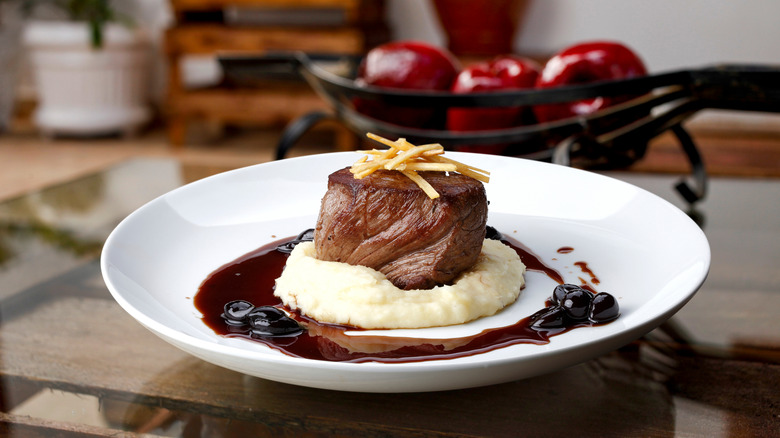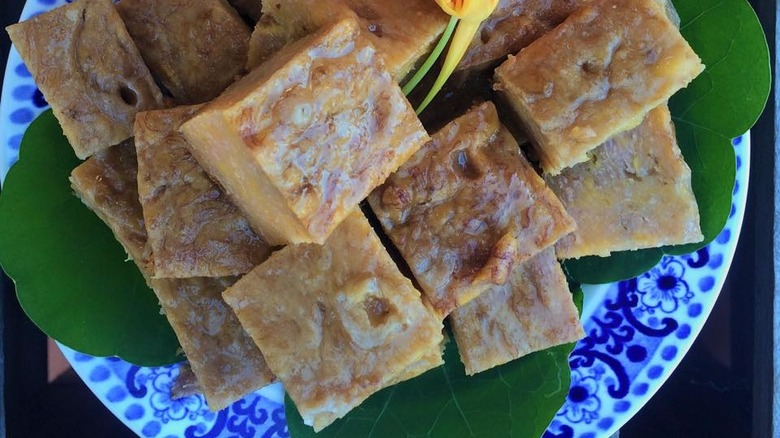International Thanksgiving Dishes You Need To Try At Least Once
Turkey, mashed potatoes, and stuffing are all delicious, but maybe you're a little bored of the standard U.S. American Thanksgiving fare. Luckily, there are many ways to incorporate new foods onto your holiday plate. You can always dust off those cookbooks on your shelf. Or, you can include dishes from the Wampanoag people, who were at the first Thanksgiving, such as corn cakes and three sisters stew. Another route is to go with international cuisine.
It's not just the U.S. that celebrates Thanksgiving. While some countries like the U.K., Brazil, and Australia more or less celebrate a form of the holiday modeled off the U.S., some countries have their own harvest festivals or versions of Thanksgiving. Countries that celebrate these days include Canada, Japan, Germany, Liberia, China, and Grenada. If you'd like to add something new to your turkey-day menu, consider one of these international Thanksgiving dishes that you have to try at least once.
1. Spicy pumpkin pie
With some notable exceptions, Canadian Thanksgiving and its traditional foods aren't too different from those in the United States. To begin with, those with dual citizenship get two Thanksgivings in a year, as Canadians celebrate their holiday on the second Monday in October. It's a lower-key holiday with more pronounced religious roots. Many of the activities people do, and foods they eat are similar but with a bit of a different take. Canadian pumpkin pie, for instance, is spicier than its Southern counterpart.
A Canadian pumpkin pie will surely include plenty of ginger, nutmeg, cloves, and cinnamon. While a traditional pumpkin pie recipe in the United States might consist of a teaspoon or two of a pumpkin pie spice blend, you can expect about one teaspoon of each spice in a traditional Canadian recipe. If you want to try your own Canadian pumpkin pie this year, you don't need to do much to adapt your favorite recipe. Simply up the amount of spice you add to your filling, et voilà.
2. Tourtière
Tourtière, pronounced tour-tee-air, is a French Canadian meat and potato pie eaten all over the country on holidays, including Thanksgiving. An iconic Canadian food you need to try before you die, tourtière can be served as a main dish instead of ham or turkey. (You can even use turkey in your tourtière). However, traditionally, pork and/or beef are used. This is a very autumnal and wintry dish seasoned with cinnamon, nutmeg, cloves, and black pepper. All in all, tourtière is very similar to a mincemeat pie.
This pie originated in the province of Quebec and has since spread throughout the country and to northern parts of the United States. While the exact origin of its name is unknown, it may come from the word "tourtes," a type of pigeon, an original ingredient in the pie. This dish also has pretty old roots, dating back to the 1600s, which is pretty impressive considering Canadian Thanksgiving has only been an official holiday since 1879.
3. Kinpira gobo
While some Japanese people celebrate American Thanksgiving, the country has its own holiday, Kinro Kansha no Hi (literally Japanese Labor Thanksgiving Day). Kinro Kansha no Hi is on November 23, close to the fourth Thursday in November. Schoolchildren often make gifts for service workers. The goal of this holiday is to be grateful for the work of laborers, so it's somewhat of a mashup of Thanksgiving and Labor Day. So, what do people eat on Kinro Kansha no Hi?
This holiday grew out of the tradition of a harvest festival in which the emperor would offer the season's first rice to the gods and then eat some himself. Perhaps then, it's no surprise that while each family has its own traditions, most include rice on their tables. Other common foods include fish, tea, and vegetable dishes like kinpira gobo (keen-pea-rah go-bo, a stir-fry of braised burdock root, and carrots. While stir-fried, you don't eat this dish of juliened vegetables hot. Flavored with vinegar, soy sauce or tamari, sake, and sometimes dashi and topped with sesame, its delicate flavor makes kinpira gobo an excellent addition to bento boxes — or your Thanksgiving plate.
4. Roast goose
Germany, Austria, and Switzerland celebrate the harvest festival called erntedankefest (airn-teh-dawnk-fest). This harvest festival of thanks is usually celebrated on the first Sunday of October. This harvest festival includes time in church, presenting a townsmember with a "harvest crown," and, of course, food. There are many traditional foods, and goose is just one of the main courses. The goose is traditionally stuffed and roasted. (Even though, these days, more and more people are beginning to eat turkey à la those in the U.S.)
German goose is brined and spiced with seasonings like cinnamon, bay leaves, and mugwort. The goose is then slowly roasted and basted with jam or honey to have a crispy skin. Serve it with potatoes and sauerkraut, and you have yourself a classic German holiday meal. Goose meat can be pretty pricey and hard to source in the United States, so you can also try these flavorings on turkey or duck. If your heart is set on goose, you can find it on some online retailers if your local market or butcher doesn't carry it.
5. Jollof rice
Jollof (joe-luf) rice is a dish you can find on many West African tables for many celebrations. It also happens to be on many Liberians' Thanksgiving menus. Liberians celebrate Thanksgiving on the first Thursday of November. Though the holiday has shifted its meaning through the years, its origin does come from the United States: Liberia is about 200 years old, and its original settlers included former enslaved peoples from the U.S.
Jollof rice recipes are found throughout West Africa, and what they all have in common is that they are spicy, tomatoey rice pilaf. However, Liberian jollof rice differs in that it is very protein-forward. While Nigerian jollof rice, for example, is often vegan or can be easily made so, Liberian rice often contains chicken, shrimp, sausage, and hot dogs in a single recipe. Serve up your jollof rice with salad or a side of fried plantains for a complete meal. If you're not up for making your own, your local Nigerian restaurant will surely sell the country's version of the dish.
6. Oil down
Oil down is the national dish of the Caribbean nation of Grenada. It's neither a complicated dish to make nor a particularly fancy one; the one-pot meal is tasty and will please your Thanksgiving guests. To make this classic dish, cooks take chopped-up meat (chicken, pork, beef, or for Thanksgiving, why not try turkey?) and add it to a deep pot. Traditionally, Grenadians add vegetables like taro leaves (callaloo) and yams. It's all topped with coconut milk and thickened with flour. The main seasonings are thyme, garlic, hot peppers, and salted cod or pork. It's a savory, filling, and comforting dish. Oil down is perfect for a cozy, low-fuss Thanksgiving.
When and why do Grenadians celebrate Thanksgiving? The holiday falls on October 25 and commemorates a military intervention in 1983 against a leader who'd taken power by coup a few years prior. The year following the intervention, the country reinstated democratic rule.
7. Mooncake
Mid-Austum Festival is traditionally a harvest festival, as is one of the purposes of Thanksgiving. This festival is observed in many parts of East Asia and Southeast Asia. In Vietnam, the celebration is called Tết Trung Thu; in China, it's called Zhong Qiu Jie. While many countries in this region, including South Korea and the Philippines, have a Mid-Autumn Festival, not all eat mooncakes with as much enthusiasm as Vietnamese and Cantonese people do.
In ancient times, these pastries were tithes to the moon goddess. Now, people offer them to friends and family or purchase them at the local bakery. What are mooncakes? Traditionally, they are intricately decorated pastries often filled with bean paste or lotus seed. Sometimes, they even contain a salted egg yolk, which has an ancient meaning behind it. The yolk represents the full moon. Today, the cake represents "sweetness, family togetherness, and happiness." What a great way to celebrate Thanksgiving!
8. Fish cake
Fish cake is a typical treat served at Barbados's Crop Over festival. The Crop Over festival began in the late 18th century to celebrate the end of the sugar cane harvest season. The summertime harvest festival lost popularity in the mid-20th century but gained a resurgence in the 1970s and has been going steady ever since. Along with Carnival-type parades and shows, Bajans enjoy the food stalls at Bridgetown Market. One of the foods you can find at the market is fish cakes.
Made from salt cod and flour, Bajan fish cakes are a local late-night specialty. Seasoned with thyme, marjoram, and parsley and spiced with chili pepper, this beloved street food is ubiquitous. Fish cakes are traditionally served with a sauce that combines hot sauce, mayonnaise, and ketchup. Even if you never make it to the island itself, this Bajan treat would be a great addition to your Thanksgiving hors d'oeurves platter.
9. Kpekple (or kpokpoi)
Kpekple (bake-bleh) or kpokboi (boke-boy) is a traditional dish served by the Ghanaian Ga people on Homowo (homo-wa). Homowo is a harvest festival that literally means "hoot at hunger." Kpekple is always served with palm nut soup, and making both dishes is quite a process. To make kpekple, cooks must grind corn and let it soak overnight.
The next day, they pass it through a sieve to remove charred pieces. While that's happening, they boil okra to use as a binder for the kpekple and heat palm oil with tomato paste to cook the dish. Cooks then mix and beat the fermented corn meal in a pan while occasionally adding oil and okra to keep the mix solid. The mixture is then put through a sieve again before serving. Kpekple is eaten alongside a palm nut soup filled with meat and smoked fish. People also take this traditional food and scatter bits of it around the town.
10. Pongal
In January, Tamil people celebrate a harvest festival called Pongal by eating a type of food by the same name. The Pongal festival honors the earth, most notably the sun god, but the festival's name comes from the Tamil word for "boil over" (pongu), so it is heavily connected to the food item, which can be sweet or savory.
Savory (ven) pongal is a lightly spiced porridge made from rice and mung dal. It's both a breakfast and a wedding food that people eat with dosas or idlis. Sweet (sakkarai) pongal is made with jaggery or palm sugar. People usually cook pongal in a clay or brass pot. Common flavorings for pongal include ghee, cardamom, ginger, and asafoetida.
There are important traditions when it comes to the manner of cooking and serving pongal. Depending on the day of the festival, in addition to eating it with their friends and family, celebrants either offer their dish to the sun god or cows. Additionally, in honor of celebrating abundance, cooks are to let the milk boil over and shout, "Pongalo, pongal!" when it does.
11. Songpyeon
Songpyeon (soŋ.pʰjʌn) is the iconic food served during Chuseok, South Korea's Thanksgiving or Mid-Autumn festival. Songpyeon are sweet rice cakes stuffed with things like red beans, chestnuts, pumpkin, or brown sugar. The rice flour dough is colored with different foods, like matcha or squash. Traditionally, you steam songpyeon over pine needles (song means pine tree), which lends the dish a subtle nutty flavor. The origin of this practice is said to be that people thought the pine tree's chi (life force) would transfer to cake and eventually to those consuming it, thereby making them strong like the tree. Others say the tree's natural properties helped act as a preservative for the songpyeon.
While in days past, families would make these treats together, it's more common to buy them ready-made these days. Whether you make or purchase them, songpyeon is a particularly great option for those looking for something sweet that's gluten-free and vegan to serve on their Thanksgiving table.
12. Dutch apple pie
Many of the people who first landed at Plymouth Rock in 1620 took a decade-long layover in the Netherlands after departing England. They lived in the city of Leiden, and even now, people in that city gather in a Gothic church on the day of American Thanksgiving to give thanks that the original pilgrims made it over here. If you find yourself wanting to incorporate Dutch traditions into your Thanksgiving, consider a Dutch apple pie recipe.
What makes a Dutch apple pie different from a standard U.S. one? And what's the real difference between Dutch and French apple pies? Well, the one you'll most likely see on an American Thanksgiving table has a top and bottom crust. On the other hand, a Dutch apple pie is a couple of things. In the United States, a Dutch apple pie is a single-crust apple pie with a streusel topping. In the Netherlands, a Dutch apple pie (or appeltaart) is a deep-dish apple pie, much like ... an American apple pie. Whichever way you go, your tummy is sure to be happy!
13. Jabuticaba sauce
It is possible that Brazil — or rather, some Brazilians — celebrate Thanksgiving thanks to a 1940s Brazilian ambassador to the U.S. It's said he returned to his homeland and suggested Brazil add the holiday to its roster. It has more or less stuck and is similar to the United States holiday. Same day, same dishes, except instead of cranberry sauce, they serve jabuticaba sauce.
Jabuticaba fruits (Plinia cauliflora) are sweet-tart, thick, and grape-like. While they don't grow in bogs like cranberries, they have their own interesting growth pattern. The fruits grow on the trees and branches of the jabuticaba tree, which can bear fruit five to six times a year. While buying jabuticaba fruit might be difficult for most of us here in the United States, you can search for premade jams or sauces on online retailers or at Latin American specialty shops. Or, you can always try growing a tree and harvesting your own fruit.
14. Banana pilhi
Norfolk Island celebrates Thanksgiving, but the small ocean-surrounded island doesn't raise turkeys, so they eat foods like chicken, roast pork, and many bananas. Before we get to the food: If you're wondering — like we were — why this tiny Australian territory in the Pacific Ocean observes Thanksgiving, no worries. At one time, many American whaling ships made port at Norfolk Island. Eventually, one brought along Thanksgiving, now celebrated on the fourth Wednesday in November. It's a more church-centered holiday than here in the U.S., but it's also one of the island's most significant holidays.
But of course, the food scene on Norfolk Island isn't exactly the same as in the United States. One of the popular dishes is banana pilhi, a baked banana dish comprising ripe bananas, flour, a raising agent, and salt. The ingredients are mashed together and then baked. The recipe ends up as a sort of banana bread or cake. This is a really simple and tasty treat to add to your Thanksgiving feast!
With so many wonderful international Thanksgiving flavors and celebrations, you really cannot go wrong. The true question is, where to start?
